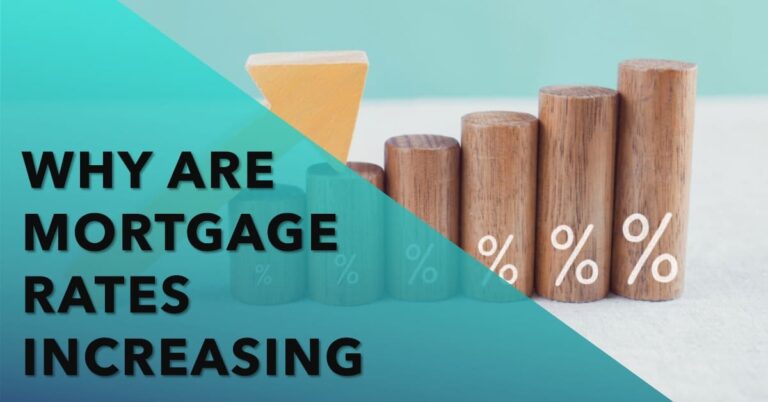If you are thinking of buying a home or refinancing your existing mortgage, you might be wondering why mortgage rates are so high in 2023. Mortgage rates have been climbing steadily since December 2021, when they hit a record low of 2.97%. As of October 12, 2023, the average 30-year fixed-rate mortgage was 7.57%, according to data from Freddie Mac. That’s the highest level since December 2000.
Why are Mortgage Rates Going Up in 2023?
Factors Affecting Mortgage Rates
There are several factors that affect mortgage rates, but the main one is the Federal Reserve’s monetary policy. The Fed has been raising its benchmark interest rate, the federal funds rate, to combat inflation and cool down the overheated economy. The federal funds rate influences other interest rates, including mortgage rates, by affecting the supply and demand of money in the financial system.
The Fed has raised the federal funds rate seven times in 2022 and another four times so far in 2023, with the latest 25-basis-point rate hike coming at its July meeting. The Fed’s target range for the federal funds rate is now between 5.75% and 6%, up from 0.25% and 0.5% at the end of 2021.
The Fed’s rate hikes are a response to the high inflation that has been plaguing the U.S economy since the pandemic. The Fed’s preferred inflation measure, the core Personal Consumption Expenditures index, is currently 3.9%, which is nearly double the Fed’s target of 2%. The core PCE index excludes volatile food and energy prices and is considered a more accurate indicator of underlying inflation trends.
The Fed believes that inflation is mainly driven by temporary factors, such as supply chain disruptions, labor shortages, and pent-up demand from consumers who have accumulated savings during the lockdowns. The Fed expects that inflation will moderate as these factors fade and the economy returns to normal.
However, some economists and market participants are worried that inflation may be more persistent and structural than the Fed anticipates. They point to rising wages, higher commodity prices, and stronger consumer spending as signs that inflationary pressures are not going away anytime soon. They also argue that the Fed’s massive bond-buying program, known as quantitative easing or QE, has created excess liquidity in the financial system that fuels inflation.
The Fed has been tapering its QE program since November 2022, reducing its monthly purchases of Treasury and mortgage-backed securities from $120 billion to $60 billion as of October 2023. The Fed has signaled that it will end its QE program by March 2024, paving the way for more rate hikes later next year.
Prepayment Risk and its Impact on Mortgage Rates
Another factor that affects mortgage rates is prepayment risk. Prepayment risk is the risk that borrowers will pay off their mortgages early when interest rates fall, depriving lenders of future interest income. Prepayment risk is higher for U.S mortgages than for other types of loans because U.S mortgages can be prepaid without penalty.
When prepayment risk is high, lenders charge higher interest rates to compensate for the potential loss of income. Prepayment risk is currently high because mortgage rates have risen so much that many borrowers who refinanced in recent years are unlikely to refinance again anytime soon. As a result, lenders are stuck with low-yielding mortgages on their books for a long time.
According to Brookings Institution researchers Wendy Edelberg and Noadia Steinmetz-Silber, prepayment risk accounts for about 1.1 percentage points of the roughly 3 percentage point gap between 10-year Treasury rates and 30-year mortgage rates. The other components of the gap are the primary-secondary spread (the margin that mortgage originators keep for themselves) and duration risk (the risk that longer-term loans are more sensitive to interest rate changes).
Impact of High Mortgage Rates on the Housing Market
The high mortgage rates have a negative impact on the housing market, which is already facing significant affordability challenges due to low inventory, high demand, and rising home prices. According to Freddie Mac’s chief economist Sam Khater, purchase demand remains at a three-decade low. Higher mortgage rates also make refinancing less attractive for homeowners who want to lower their monthly payments or tap into their home equity.
Outlook and Considerations for Mortgage Rates
The outlook for mortgage rates depends largely on how inflation evolves and how the Fed responds. If inflation proves to be transitory and falls back to the Fed’s target range, then mortgage rates may stabilize or decline slightly in the coming months. However, if inflation remains elevated or accelerates further, then mortgage rates may continue to rise as the Fed tightens its monetary policy more aggressively.
For prospective homebuyers and homeowners who want to refinance, it may be wise to lock in a low rate while they still can, before mortgage rates go up even more. However, they should also consider other factors, such as their income, credit score, debt-to-income ratio, and down payment, that affect their ability to qualify for a mortgage and afford the monthly payments.





